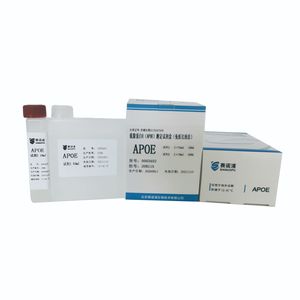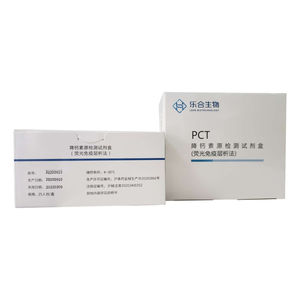
- Laboratory
- Laboratory medicine
- Solution reagent
- Beijing sainuopu Biotechnology Co., Ltd

- Products
- Catalogs
- News & Trends
- Exhibitions
Solution reagent kit APOA1serumantibodytissue
Add to favorites
Compare this product
Characteristics
- Type
- solution, serum, antibody
- Applications
- tissue
- Format
- liquid
- Tested parameter
- lipoprotein, for apolipoproteins, density, cholesterol
Description
It is used to detect apolipoprotein A1 in human serum.
Apolipoprotein A1 is the main component of high density lipoprotein (HDL). The main role of apolipoprotein A1 is to activate lecithin cholesterol fatty acyltransferase (LCAT) and remove free cholesterol from extrahepatic tissue. Apolipoprotein A1 is a marker of anti-atherosclerosis.
【Expected Use】
It is used to detect apolipoprotein A1 in human serum.
Apolipoprotein A1 is the main component of high density lipoprotein (HDL). The main role of apolipoprotein A1 is to activate lecithin cholesterol fatty acyltransferase (LCAT) and remove free cholesterol from extrahepatic tissue. Apolipoprotein A1 is a marker of anti-atherosclerosis.
【Testing Principle】
APOA1 in the sample reacts with specific apolipoprotein A1 antibody in the reagent to form an insoluble complex, which results in turbidity of the reaction solution. The turbidity is related to the concentration of APOA1 in the sample. The turbidity of the insoluble complex can be determined by measuring the absorbance of 340 nm. By measuring a series of calibrators to establish a working curve of absorbance versus concentration, the concentration in the sample can be determined.
【Test Method】
1. Reagent preparation: liquid double reagent, no need to prepare direct use.
2. Test conditions: The test environment is not more than 95% at temperature (15-37)degrees Celsius and relative humidity.
【Performance Index】
Analytical sensitivity: When the concentration is 0.15g/L, the absorbance change value (A) should be no less than 0.05.
Linear range: 0.1-2.0 g/L
Accuracy: Relative deviation < 10%.
Accuracy: Repeatability<5%; Inter-batch Difference <10%.
Other Beijing sainuopu Biotechnology Co., Ltd products
Products
Related Searches
- Solution reagent kit
- Protein reagent kit
- Diagnostic reagent kit
- Laboratory reagent kit
- Histology reagent kit
- Immunology reagent
- Antibody
- Buffer solution reagent kit
- Quality control reagent kit
- Bacteria reagent kit
- Blood sample reagent kit
- Tissue reagent kit
- Serum reagent kit
- Enzyme reagent
- Monoclonal antibody reagent kit
- Calibration reagent kit
- Antibody reagent kit
- Vitamin reagent kit
- Immunoturbidimetric reagent kit
- Cholesterol reagent kit
*Prices are pre-tax. They exclude delivery charges and customs duties and do not include additional charges for installation or activation options. Prices are indicative only and may vary by country, with changes to the cost of raw materials and exchange rates.



















